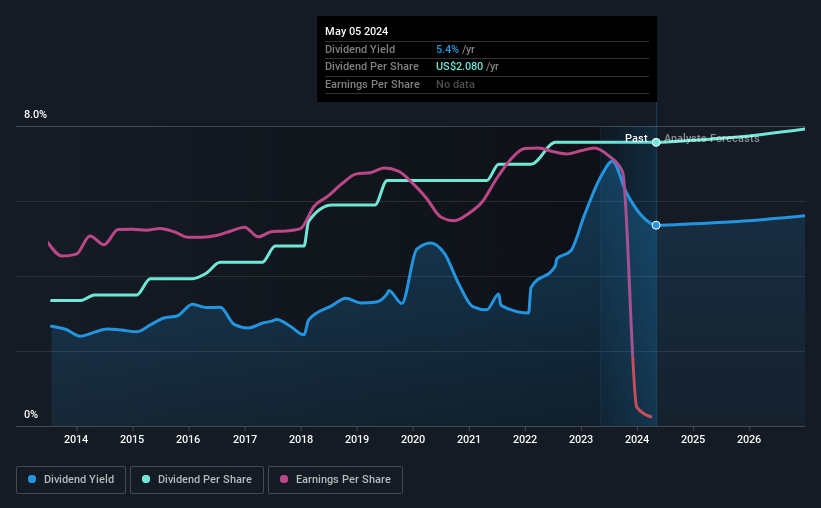It Might Not Be A Great Idea To Buy Truist Financial Corporation (NYSE:TFC) For Its Next Dividend

Regular readers will know that we love our dividends at Simply Wall St, which is why it’s exciting to see Truist Financial Corporation (NYSE:TFC) is about to trade ex-dividend in the next three days. The ex-dividend date is one business day before the record date, which is the cut-off date for shareholders to be present on the company’s books to be eligible for a dividend payment. The ex-dividend date is an important date to be aware of as any purchase of the stock made on or after this date might mean a late settlement that doesn’t show on the record date. Thus, you can purchase Truist Financial’s shares before the 9th of May in order to receive the dividend, which the company will pay on the 3rd of June.
The company’s next dividend payment will be US$0.52 per share. Last year, in total, the company distributed US$2.08 to shareholders. Based on the last year’s worth of payments, Truist Financial has a trailing yield of 5.4% on the current stock price of US$38.85. We love seeing companies pay a dividend, but it’s also important to be sure that laying the golden eggs isn’t going to kill our golden goose! So we need to investigate whether Truist Financial can afford its dividend, and if the dividend could grow.
Check out our latest analysis for Truist Financial
Dividends are usually paid out of company profits, so if a company pays out more than it earned then its dividend is usually at greater risk of being cut. Truist Financial’s dividend is not well covered by earnings, as the company lost money last year. This is not a sustainable state of affairs, so it would be worth investigating if earnings are expected to recover.
Click here to see the company’s payout ratio, plus analyst estimates of its future dividends.
Have Earnings And Dividends Been Growing?
Businesses with shrinking earnings are tricky from a dividend perspective. If earnings decline and the company is forced to cut its dividend, investors could watch the value of their investment go up in smoke. Truist Financial reported a loss last year, and the general trend suggests its earnings have also been declining in recent years, making us wonder if the dividend is at risk.
Many investors will assess a company’s dividend performance by evaluating how much the dividend payments have changed over time. Since the start of our data, 10 years ago, Truist Financial has lifted its dividend by approximately 8.5% a year on average.
Get our latest analysis on Truist Financial’s balance sheet health here.
Final Takeaway
Is Truist Financial an attractive dividend stock, or better left on the shelf? First, it’s not great to see the company paying a dividend despite being loss-making over the last year. Worse, the general trend in its earnings looks negative in recent years. These characteristics don’t generally lead to outstanding dividend performance, and investors may not be happy with the results of owning this stock for its dividend.
So if you’re still interested in Truist Financial despite it’s poor dividend qualities, you should be well informed on some of the risks facing this stock. For example, we’ve found 1 warning sign for Truist Financial that we recommend you consider before investing in the business.
A common investing mistake is buying the first interesting stock you see. Here you can find a full list of high-yield dividend stocks.
Have feedback on this article? Concerned about the content? Get in touch with us directly. Alternatively, email editorial-team (at) simplywallst.com.
This article by Simply Wall St is general in nature. We provide commentary based on historical data and analyst forecasts only using an unbiased methodology and our articles are not intended to be financial advice. It does not constitute a recommendation to buy or sell any stock, and does not take account of your objectives, or your financial situation. We aim to bring you long-term focused analysis driven by fundamental data. Note that our analysis may not factor in the latest price-sensitive company announcements or qualitative material. Simply Wall St has no position in any stocks mentioned.
Source link






